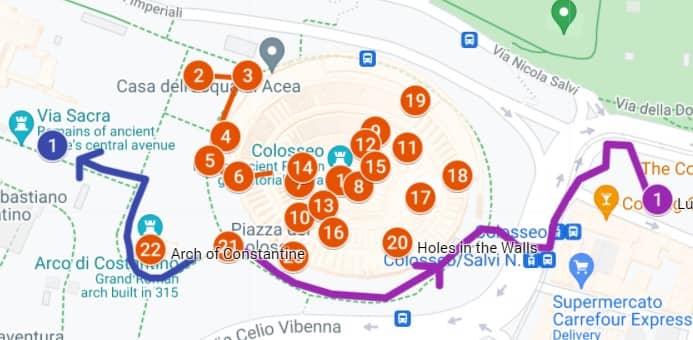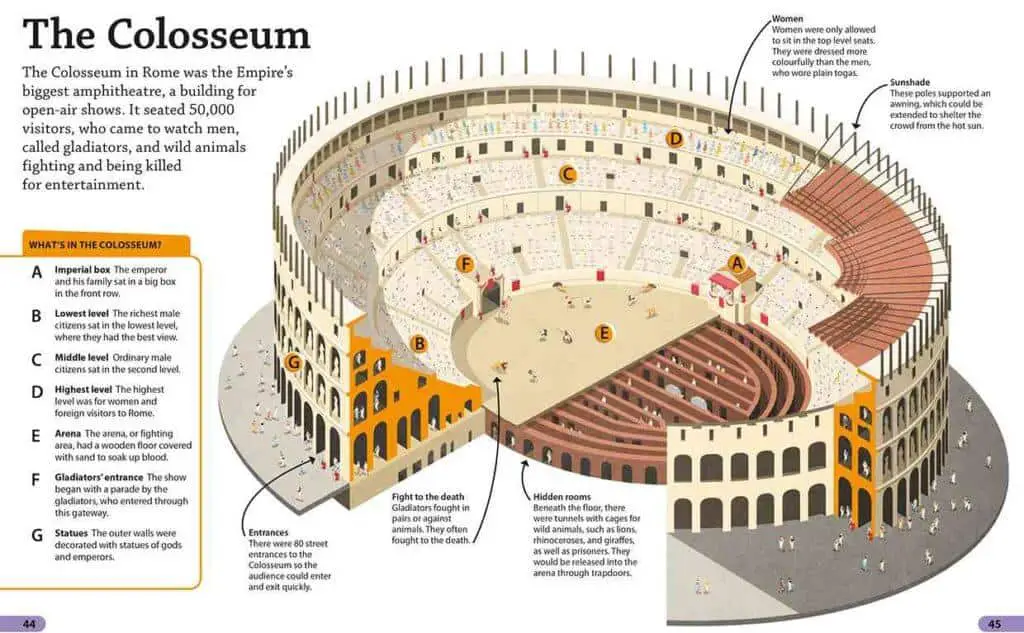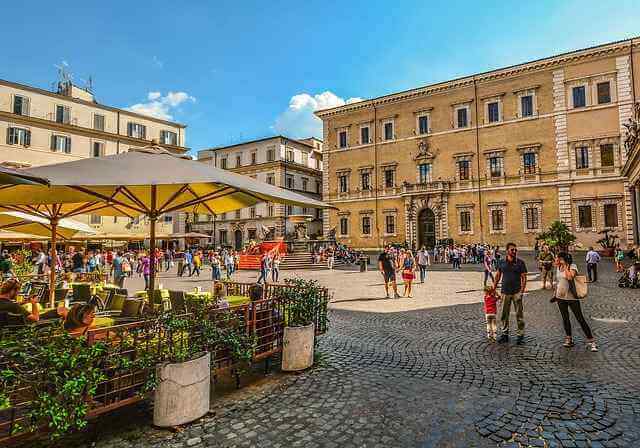Inside the Colosseum, Roman Colosseum Layout and Facts
Nero’s new Palace – Why was the Roman Colosseum Built?
A visit to the Roman Colosseum is not complete without an understanding the history and layout of the Roman Colosseum. In 64AD a nine day fire ravaged many of Ancient Rome’s buildings. Emperor Nero used this event to build himself a new palace in the roman forum and Nero moved his palace from the Palatine hill. It was rumored that Nero caused the fire in order to make room for a palace for himself in the forum.
Nero’s palace included a colossal monument of himself, 37m high, and a man made lake as part of the entrance to his “golden palace” (Domus Aurea). Nero was greatly disliked for his lavish lifestyle and excesses. Eventually the fire, the empty treasury, civil war within the territories and general malcontent with his leadership led to Nero’s downfall. He heard that he would be declared an enemy of the public by the senators. Before this was finalized he committed suicide at the age of 28 in 68AD.
Re-creation of Nero’s opulent Palace and man-made lake
The palace was destroyed to build the Roman Colosseum
Before your visit to the Roman Colosseum, imagine the massive and opulent palace, (shown in the video below), that occupied the land on which the Roman Colosseum was built. Nero commissioned a colossal statue of himself that the Romans referred to as “the colossus”. The massive stature of Nero was partially changed to resemble the Sun God. The name for the Roman Colosseum likely comes from the colossal bronze statue of Nero.
Roman Colosseum Layout for Self Guided Walking Map of Attractions

Entry Tickets to the Roman Colosseum
The lineups to visit the Roman Colosseum are long, the best option is to purchase your “skip the line” tickets online. Book your tickets in advance to avoid the lineups. Options include combination tickets and tours to the Colosseum underground, select the one that best suits you. Combine this with nearby attractions such as the Roman Forum and Palatine Hill forum fast entry tickets and tours.
The Building of the Roman Colosseum
Upon Nero’s death and after 18 months of upheaval, Emperor Vespasian of the Flavian Dynasty ruled Rome. Vespasian was a general in the army and did not come from royal lineage. Once he became emperor, he wanted to give the land that Nero took, back to the people and build an entertainment venue for them with free entrance and free food. He decided to build a Colosseum for the people of Rome where Nero’s hated palace stood. Emperor Vespasian drained the man-made lake of the palace and built the Roman Colosseum on that site.
History of the Roman Colosseum – Flavian Dynasty
In 72 AD Vespasian, of the Flavian family Dynasty, commissioned the building of the colosseum at the site of Nero’s golden palace. He drained the manmade lake of Nero’s palace, raised the ground level 23 feet to make room for the colosseum and repurposed the statue to represent the sun god Solis instead of Nero. On your visit to the Roman Colosseum, notice that the Colosseum is at a higher ground level that the Roman Forum. The raising of the ground level is the reason that the colosseum is at modern day Rome ground level and not at the level of the Roman Forum. Rome is about 2600 years old and the ground level has been rising at a rate of approx. 7.6mm a year due to accumulation of debris.
The Roman Colosseum layout was designed on the amphitheater concept, where the two semi-circles would join to form an ellipse of the Colosseum and the base would be the area for gladiator games and other forms of entertainment. Vesapsian ruled for 10 years, however he died before the colosseum was completed. His son Titus would complete the colosseum and Titus’s younger brother Domitian added the basement (hypogeum) and a top level for standing room only.
The Flavian Emperors were known to have toned down the excess of the Roman court and promoted the welfare of the people. They were well-loved rulers and had people’s support especially in the way they handled the aftermath of the damage caused by the eruption of Mt Vesuvius and the destruction of Pompeii and Herculaneum.
When you visit the Roman Colosseum, the hypogeum will not be open to the general public and is only accessible if you hire a qualified underground guide or purchase a ticket for a tour of the hypogeum. Visitors cannot wander the halls of the hypogeum without an official guide.
Roman Colosseum Inside Layout
The Roman Colosseum was referred to as the Flavian Amphitheater and opened after a decade of building using 100,000 slaves and 100,000 cubic meters of travertine limestone quarried from Tivoli 20 miles away. Use of a variety of materials beside travertine such as brick, concrete and volcanic pumice gave the building some elasticity and has helped keep it standing all these years.

Inside the Colosseum: Construction of the Roman Colosseum
The Colosseum is a building built on 6 acres with 4 floors and 3 stories high and it took about 10 years to build. The Roman Colosseum layout includes the first three stories that have arches and the fourth has rectangular windows. Inside the Colosseum, the main floor includes 80 arched entrances with 300 tons of metal clamps and an additional 80 arch column design on each of the upper floors to support the structure. It was the largest amphitheater in Rome with a capacity of 50,000 spectators was 45 meters in height (150 ft) with a width of 190×155 ft (620.513 sqft)
On your visit to the Colosseum, notice that the columns on the main floor of the Roman Colosseum are simple and of Doric style and those on the second level are Iconic style, where the third level columns were more ornate and of Corinthian style. The top level has Corinthian pilasters with small rectangular windows
Inside the Colosseum Structure:
A visit to the Roman Colosseum is not complete without noticing the many archways that are entrances. Each entrance has a roman numeral carved into top of the archway to help guide the crowd into using the correct entrance. There are 80 entrances to the Roman Colosseum. There are entrances two for gladiators, two entrances for the Emperor/Magistrates and the other 76 numbered entrances were for the rest of the people. The South entrance was for the Emperor, senate and Vestal Virgins; the North entrance was for the Magistrates. Today the north entrance is called the Stern entrance and is used for group tours.
The Roman Colosseum layout includes a system of entrances, corridors and steps were designed to allow 50,000 people to exit the area in 10 minutes after the show was done. The passages behind each tier of seats were called vomitoria. The vomitorium allowed for such a quick exit, and that is where the term vomit comes from. The Latin word vomitorium comes from the root word vomere, which literally means “to spew forth”. The entrances were labelled and tickets, (in the form of broken tiles) had the entrance, section and seat number etched on it. The four stories had seats that were assigned according to the social class. You could not purchase better tickets if you paid more money as tickets were free and assigned by the social class you belonged to
Video of the layout inside the Roman Colosseum including Seating, Arena Floor, Hypogeum, Emperors Entrance
Layout of the Seats inside the Roman Colosseum
On your visit to the inside of the Roman Colosseum, note the large number of seats from the main floor to the top floor. There was a seating order in the colosseum and unlike the tickets today, you could not purchase better or more expensive tickets:
Seating arrangement
- The first/main level – The emperor’s box and the senators; vestal virgins were in seats next to the emperors box. This is similar to ringside seats of today. These seats were made of marble
- The lowest level – These seats were reserved for knights, nobility and rich roman citizens. These seats and the rest of the seats were made of travertine limestone
- The next level up – Ordinary Roman citizens
- The next level up – reserved for women, poor romans and freed slaves
The Layout of the Main Arena inside the Roman Colosseum
The main arena was oval and it was 87 x 54 meters containing 36 trap doors and an elevator system that brought up props, scenery, gladiators and animals from the underground hypogeum. The wooden floor of the arena was covered in 9 inches of red sand to mask the blood spilled during battle. Interestingly, the Latin word for sand is arena. At this time there is no floor in the arena and the hypogeum with its underground tunnels, cages and elevators beneath is exposed. The wooden floor was stripped away and used in other buildings in Rome. If you visit the Roman Colosseum in the future, you may see a floor. There are plans to reconstruct the Roman Colosseum floor and eventually use the area for concerts and other events.
The area was often changed with eye catching scenery that was based on the game or entertainment being showcased. For game hunting, this would be trees, landscaping, rocks and other props. No visit to the Roman Colosseum is complete without an understanding of the resources that were expended to keep the Roman Colosseum functioning as an entertainment venue for the populace.
Inside the Colosseum there are 80 entrance/exits into the arena. Two were reserved for gladiators as follows:
- The Porta Sanivivaria entrance, Gate of Life. This was the east entrance/exit were the surviving gladiators walked out of the area. This exit was connected by tunnel to the Ludus Magnus gladiator school to the east
- The Porta Libetina; It’s the Gate of Death. This was the west entrance/exit for those gladiators that did not survive. Libertina was the goddess of funerals. It led to the Spoliarium beneath the arena where the bodies were stripped of weapons and armour
The underground Hypogeum layout inside the Roman Colosseum is an engineering marvel:
Emperor Domitian added the Hypogeum during his reign. The layout inside the Roman Colosseum included 2 underground levels, approximately 24 feet high, consisting of corridors and cells with 32 pens that housed animals, props, cages, equipment and gladiators. It used a hoisting device called Hegmata to bring up the heavy animals such as elephants. The layout allowed for a well designed elevator system at the Roman Colosseum, complete with pulley’s, hinges and levers run by slaves transported the “performers” and props from the underground into the arena above. There were constant scenery changes to entertain the crowd and the underground area had to run with precise timings to accommodate the performances above. To pull this off there were animal trainers, stage hands for props, manual labour for hoisting animals plus coordinators who ensured precise timing; the underground area was a hive of activity.
The Hypogeum layout also had a network of sewer and drainage system that drained the toilets and fountains into the main sewer system outside of the Roman Colosseum
The layout of Roman Colosseum included a Retractable Roof – The Awning
Above the top floor are about 240 holes that supported wooden beams which then supported a retractable awning (velarium) made of net and canvas. You may be able to see remnants of this on your visit to the Roman Colosseum. It was used to shade the arena from the hot sun, light rain or other adverse weather conditions. These were controlled by sailors from the imperial fleet
Colosseum History: The Glory Years
The Colosseum was inaugurated in 80AD by Emperor Titus with 100 continuous days of games. In those 100 days, more than 2,000 gladiators and estimated 5,000 to 11,000 animals were killed. In total it is estimated that over 500,000 people and 1 million animals, (some to almost extinction) died in the arena
Attendance to the Roman Colosseum was free and also included food. Games often lasted from dawn to nightfall, starting off with a chariot procession accompanied by trumpeters. The procession circled the arena and ended with a salute to the emperor.
Typical day at the Roman Colosseum:
The layout of the Roman Colosseum was designed such that Roman’s could spend the entire day at the Colosseum. THe games usually started with combat events between women, dwarfs, and disabled people using wooden weapons. Sometimes there were female gladiators using swords and other weapons used by male gladiators. Following this, there would be the animal hunts using hippos, tigers, lions, elephants and other wild animals. Sometimes defenseless animals were used such as giraffes, ostriches, and deer. Occasionally there were plays of famous roman victories where prisoners were sacrificed as part of the battles.
The day ended with gladiator combat, The gladiators were slaves, condemned criminals, prisoners of war either civilians or soldiers. The general form tended to be animal entertainment in the mornings, criminal executions in the afternoon and gladiator combats of battle reconstruction at the end of the day
The Romans enjoyed these great spectacles and display of their power and might. There is some documentation that refers to sea battles that were fought in the colosseum, with armed armadas fighting each other in the arena that was filled with water. The water battles showcased naval ships and the might of the Roman Naval Fleet. Today there is great debate as to how and if this was possible
Colosseum History: The Decline
There was a change in the way that the Romans viewed the games in the late 4th century. The Roman Empire had embraced Christianity and the gladiator games were not consistent with Christian values. Over time people stopped attending the games as they viewed the games as inhuman and cruel acts. The church was encouraging the citizens to attend church, religious events and festivals instead. Eventually the games stopped due to lack of spectators; people just stopped coming. Even the emperors and leadership distanced themselves from the games to align themselves with the values of their citizens. After 400 years of active use, in 438 AD, gladiator fighting was abolished with the last recorded use was an animal hunt game in 523AD coinciding with the end of the Roman Empire
Natural weather related events included lightening and earthquakes (5th, 9th and 14th century) and manmade events such as vandalism or purposeful redistribution of stones to other monuments led to the decline of the amphitheater
Today
It is one of the great wonders of the world and most visited monument in Italy
Best time to visit the Roman Colosseum
The attraction is busy at all times and the numbers of Roman Colosseum visits are capped at 3,000 at a time. They have introduced a new system whereby all tickets have a time slot. You can only enter at your specified timeslot however you are given 15 min leeway on your timeslot. If you miss it, you lose the ticket. There are no exceptions and the attendants check the ticket very closely for the timeslot. Before you visit the Roman Colosseum make sure you are aware of your time!
Once the maximum of 3,000 is reached you can enter, as one out and one in, even if you have a specific timeslot. They will wave you in as others exit so that they maintain the 3,000 person maximum capacity. When you visit, you will have to wait in line to get into the Roman Colosseum then wait in the security check line, and then wait again in the turnstile line, so you will need some patience for the entire process
Best times to visit the Roman Colosseum are in the low tourist season between October and March and the best times to visit during the day are first thing in the morning when the Roman Colosseum opens or late afternoon after 4pm. The morning group tours begin at 10am and its very busy at that time. The lineups are shorter, so you may want to book your time slot for those times. At midday during the peak season, you will be jostling with the thousands of tourist to get a glimpse of some of the attractions you want to visit in the Roman Colosseum
Purchase Roman Colosseum Tickets BEFORE you visit:
There are five ways to purchase the Colosseum Tickets
Arrive 30 minutes prior to you booked time slot so you can get through the line ups to enter at your scheduled time slot
- Onsite
- Purchase tickets, at the Roman Colosseum Ticket Office (Piazza del Colosseo) – there is a long line up to purchase tickets and you will need to specify a time sl l ot when you purchase the tickets. There are maximum number of tourists allowed per day and once that is reached they will not sell any more tickets for that day. Usually in peak season, the maximum is reached at mid-day and after that you will not be able to buy tickets for that day
- Buy tickets at the Roman Forum Ticket office (Largo Salara Vecchia) – As the regular ticket includes access to the Palatine Hill and Roman Forum, you can also buy tickets from the Roman Forum office. You will still need to book a timeslot to visit the colosseum
- Purchase tickets at the Palatine Ticket Office (in Via di San Gregorio) – As the regular ticket includes access to the Palatine Hill and Roman Forum, you can also buy tickets from the Palatine ticket office. Line ups are the shortest at the palatine office. You will still need to book a time slot for the visit to the Roman Colosseum
- Online
- Before you visit, you can purchase tickets to the Roman Colosseum online at the official website, the tickets online cost a little more but you are not standing in line to purchase them. You will need to specify a time slotfor the colosseum
- By telephone
- Call centre for information and bookings: + 39 (0)639967450 or visit the colosseum ticket office
- Buy the Roma Pass – there are two types of passes; the 48 hour pass and the 72 hour pass
- You will still need to go online and book your timeslot for the visit to the Roman Colosseum and it will cost you extra to book the timeslot however you cannot enter the colosseum without it
- Group tours
- Group tours include a ticket to visit the Roman Colosseum and the entrance is usually at the north side (Stern entrance)
Types of tickets available to visit Roman Colosseum
Roma Colosseum – regular ticket that is valid for a 2 day visit to the Roman Colosseum. Entrances to the colosseum, roman forum and palatine hill. There is only one entrance and there is no re-entry
Roman Forum-Palatine – there is a one day access to additional attractions within the Platine Hill. These includes the Cryptoporticus, Palatine museum, House of Livia tour (30 min), Domus Transitoria (30 min tour), Loggie Mattei, Santa Maria Antiqua and the Temple of Romulus. There is an additional charge to enter these attractions and it can be added to the regular ticket. You will need to book time slots for the tours to House of Livia and Domus Transitoria. The attractions are not open every day, so check the times to ensure you can visit them
Colosseum – Underground and Arena – A separate ticket needs to be purchased to visit the underground tunnels of the Roman Colosseum (hypogeum). You cannot enter without an authorized guide. Call the ticket office for authorized guide +39 (0)6 399 67 888 or book an online tour with an authorized guide; usually the ticket is included with a booked tour
The most popular tickets are listed above. There are a number of other types of tickets such as visiting the colosseum at night, etc. These can be viewed at the official website
Entrance to visit the Roman Colosseum is free the first Sunday of each month ONLY in the low tourist season. It used to be year round and has recently changed to low tourist season only
What not to Bring for your visit to the Roman Colosseum
- You will not be able to enter with large backpacks, bulky bags or luggage and trolley
- Small and medium backpacks will be screened by a metal detector and may be subject to visible screening so you may need to open it
How to get to the Roman Colosseum
You can take the public transport to the Colosseum
- Metro station line B, get off at station “Colosseo”
- Metro line A, get off at station Manzoni, take tram #3 heading south for two stops
- Public Bus #51, #75, #85, #87 and #118 all stop at the colosseum or close by
- Tram #3 also stops at the colosseum
Additional Attractions in Italy
- The Roman Colosseum Self guided tour will take you on a complete tour of the Colosseum. Click on the Roman Colosseum attractions map HERE and accompanying Colosseum attractions guide HERE
- Rome attractions map and self guided tour of Vatican City attractions map is HERE and the Vatican attractions guide is HERE
- Visit the attractions of Historic Rome with these 12 separate self guided walking tours. The walking route map is HERE and the attractions guide to the historic sites is HERE
- Self Guided Walking to explore the Roman neighborhood of Trastevere with map of attractions HERE and guide of attractions HERE
- The complete inside guide and layout St Peters Basilica. Explore all the attractions in St Peter’s Basilica with the guide HERE
- One of my favorite trips is that of the Roman Forum and Palatine Hill. The map of attractions is HERE and the self guided walking tour is HERE
- Self Guided Walking Tours – Day Trips from Rome:
- Additional information on various attractions:
- How to visit St Peter’s Basilica, including history, timelines, entrances, dress codes and climbing the Dome
- All you need to know before you visit Vatican City
- Additional information to visit the Roman Forum, including history, where to purchase tickets and hours of operation

